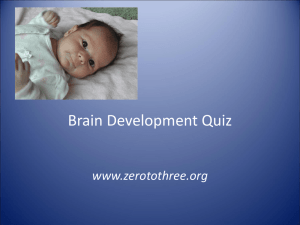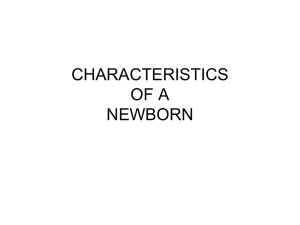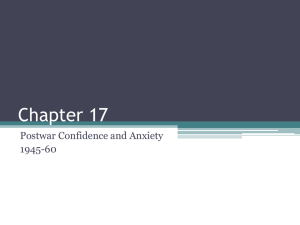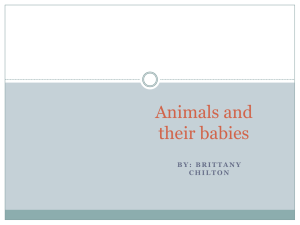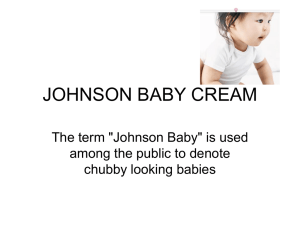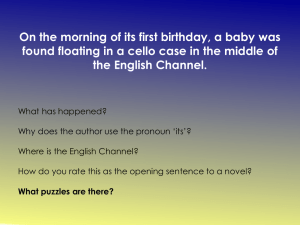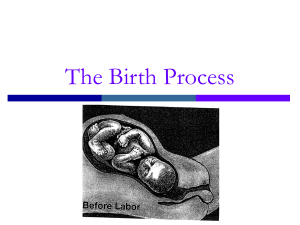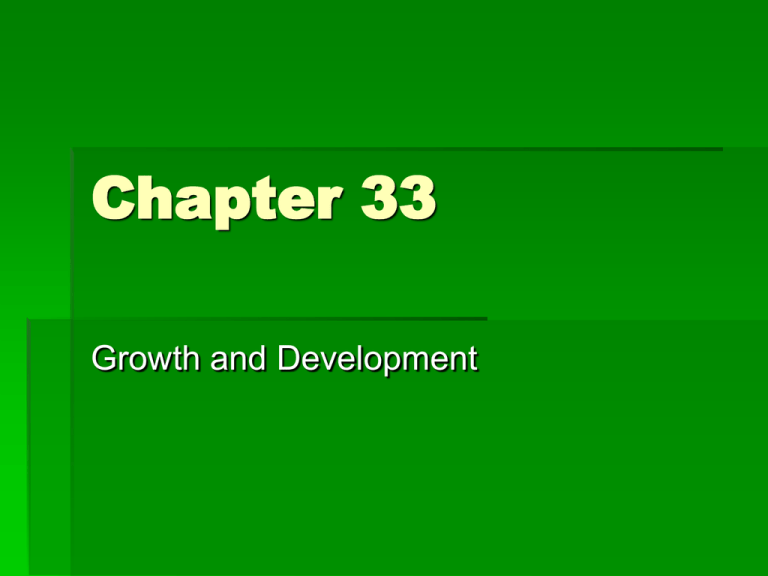
Chapter 33
Growth and Development
New Human Life
Begins with the production of sex cells
In males called spermatogenesis
In females called oogenesis
Occurs due to meiosis (remember
IPMATPMAT)
Gametes special cells in that they are
haploids, not diploid, like somatic cells
Spermatogenesis
Begins about the time of puberty, continues throughout
life
A primary spermatocyte (in seminiferous tube)
undergoes meiotic division I, forms two secondary
spermatocytes
Secondary spermatocytes undergo meiotic division II to
form four spermatids
Spermatids differentiate to form head and tail
Oogenesis
Production of female gametes
During fetal period oogonia (stem cells) multiply by mitosis
Oogonia transformed into primordial oocytes (marked by one layer of cells
suurounding the oocyte)
Primary oocyte begin the first meiotic division BUT stop at prophase I (about
500,000 present at birth, around 100,000 will die before puberty)
During childhood, ganulosa cells develop around primary oocyte to form
primary follicle
Puberty initiates the continuation of oogenesis
Each cycle, 1000 primary oocytes resume meiosis
Granulosa cells become theca cells—produce androgen (estrogen); now
secondary follicles
Only 1 will survive and mature into antrum. A mature follicle ready to burst
open from ovary surface is called a Graafian follicle
Meoisis I results in two daughter cells: a large cell called a secondary
oocyte and a small cell called a first polar body
Just before ovulation meiosis stops again, at metaphase II
LH (luteinizing hormone) causes ovulation to happen
Meiosis II resumes only if the oocyte is penetrated by the head of a sperm
If fertilization doesn’t happen, the ova disentegrates
If fertilization does occur, meiotic division continues to produces a
secondary polar body and a mature, fertilized ovum called a zygote
differences
Spermatogenesis produces four spermatozoa
Oogenesis produces only one mature ovum
and three polar bodies that disintegrate. The
cytoplasm is not equally divided among the
daughter cells, one large fluid filled cell is
necessary to store all of the organelles,
nutrients, and regulatory molecules.
Ovulation and
Insemination
Ovulation-the expulson of a mature ovum
from the mature ovarian follicle into the
abdominopelvic cavity
Insemination-expulsion of the seminal
fluid from the male urethra to female
vagina
Fertilization
After ovum is released into the abdominopelvic
cavity, it enters into the fallopian tube
Conception, fertilization, occurs here
An ovum only lives a day or so after ovulation.
Because sperm may live for a few days in the
female body, fertilization can occur if sex
occurs any time three days before up to a day
after ovulation
A fertilized ovum (zygote) is a diploid. LIFE
BEGINS—all it needs now is time to go through
growth and development
Prenatal Period
Runs from time of conception to birth (3940 wks)
The study of this period of development
is called embryology
Cleavage and Implantation
A zygote immediately begins to cleave (divide),
after 3 days it becomes a mass of cells called a
morula
The morula continues to divide to form a
blastocyst by the time it reaches the uterus
10 days from conception, the blastocyst
implants itself into the uterine lining
As the bastocyst develops further, it forms two
cavities called the yolk sac and amniotic cavity
In humans, the yolk sac is not nutritive, it has
other purposes like blood cell production
The inner lining mass of the blastocyst that will
form the tissues of the offspring
The outer layer of the blastocyst called the
trophoblast, that forms the support for the child
The amniotic cavity becomes fluid filled, shock
absorbing sac, in which the embryo floats
The chorion develops into a vital fetal
membrane in the placenta. This allows for
embryonic cirulation
The placenta anchors the developing offspring
to the uterus and provides and exchange for
nutrients and waste products from mom to
child
Placenta
Contains maternal and fetal blood supplies—
kept separated by a very thin layer of placental
tissue
Important endocrine function
Secretes human chorionic gonadotropin (HCG)
HCG stimulates the corpus luteum to secrete
estrogen and progesterone—stopping menstruation
After week ~16, placental starts secreting its own
estrogen and progesterone
At home preg. Test measure the HCG in urine
Periods of Development
Pregnancy is about 39 weeks, called
gestation period
Is divided into trimesters
1st goes from first day of last menstrual
period to the end of 12 wks
2nd goes from end of 12 wks to end of 28wk
3rd goes from end of 28 wk until the delivery
1st trimester
Use term zygote when first fertilized
Use term morula (a solid mass of cells
after 3 days) and then a blastocyst until it
implants itself into the uterus
Embryonic starts from fertilization until
end of 8wks, after 8wks until birth use
term fetus
1st trimester con’t
The first trimester (0 - 14 weeks), is one of the
most crucial for the baby.
Week 1 to week 4
Gender is determined
Implantation occurs—bleeding may occur 10-14
days after fertilization as the blastocyst imbeds itself
in uterus
Neural tube forms—will become basis of nervous
system (brain, spinal cord, hair, and skin)
Heart and primitive circulatory system forms
Week 5
First heartbeats begin – ultrasounds show heart beat
Umbilical cord develops - This the baby's lifeline in utero. It bears
the responsibility of pumping in oxygen, removing waste, and
supplying the necessary nutrients for the remainder of the pregnancy.
Blood is now pumping - All four heart chambers are now functioning
Most other organs begin to develop - infant's lungs start to appear,
along with the brain.
Arm and leg buds appear
Week 6
The arms and legs continue to develop
Brain continues growing
Lenses of the eyes appear
Nostrils are formed - The position of the nose seems to shift into its proper
place as well. Soon, the nerves running from the nose to the brain appear.
Intestines grow - Initially these are actually located outside the baby's body
within the umbilical cord.
Pancreas - The baby is now equipped to deal with digestive enzymes and
take on processing the insulin and glucagons the body needs to function.
Week 7
Elbows form, fingers develop
Feet start to appear with tiny notches for the toes
Ears eyes and nose start to appear - Although they may
resemble an alien life form, these all "shift" soon enough into a
more normal appearance.
Intestines continue to form in the umbilical cord
Teeth begin to develop under the gums
Week 8
Cartilage and bones begin to form
The basic structure of the eye is well underway
The tongue begins to develop
Intestines move out of the umbilical cord into the abdomen
Body grows and makes room
The fingers and toes have appeared but are webbed and short
Baby's length (crown to rump) is 0.61 inch (1.6cm) and weight is
0.04 ounce (1gm)
Week 9
Baby has begun movement—too small to be felt by mother
Most joints are formed
Fetus will curve its fingers around an object placed in the
palm of its hand
Fingerprints are already evident in the skin
Average size this week -- length 0.9 inch (2.3cm), weight
0.07 ounce (2gm)
Week 10
The most critical part of infant's development is complete.
Now headed into a period of rapid growth.
baby's head is now about half its length
Eyelids fuse shut and irises begin to develop - Eye color is
also determined by this point.
Placenta begins to function this week or next
baby will be about 1.22 inch long (3.1cm) and weigh 0.14
ounce (4gm) at the end of this week
Week 11
Nearly all structures and organs are formed and beginning to function.
Fingers and toes have separated
Hair and nails begin to grow
The genitals begin to take on the proper gender characteristics
Amniotic fluid begins to accumulate as the kidneys begin to function This fluid, consisting primarily of water, helps provide a cushion for baby
The muscles in the intestinal walls begin to practice contractions that
digest food
Baby is about 1.61 inches (4.1 cm) long and weighs 0.25 ounce (7gm).
Week 12
Vocal cords begin to form
eyes begin to move closer together
Ears shift to their normal place on the side of the head
Intestines move farther in child's body
liver begins to function
pancreas begins to produce insulin
baby's average size is now at a whopping length: 2.13 inches
(5.4cm) and weight: 0.49 ounce (14gm)
Week 13
infant is about 2.91 inches (7.4cm) and weighs around 0.81 ounce (23gm)
begins to practice inhaling and exhaling movements
Eyes and ears continue to move and develop
Baby's neck is getting longer, and the chin no longer is resting on chest
hands are becoming more functional—starts playing with fist
At this point all nourishment is received from the placenta
should be able to hear heartbeat with a Doppler
Week 14
Thyroid gland has matured and baby begins producing hormones
In boys, the prostate gland develops
In girls, the ovaries move from the abdomen to the pelvis
may have learned to suck his thumb
child's bones are getting harder and stronger
baby's skin is very transparent
Lanugo (very fine hair) covers the baby's body
baby is 3.42 inches (8.7cm) long and weighs about 1.52 ounces (43 grams)
Week 1
Week 6
Week 2
Week 3
Week 8
Week 7
Week 9
Week 12
Week 14
Week 13
Week 4
Week 5
Week 10
Week 11
Second Trimester
the honeymoon stage of pregnancy
Week 15
may begin to feel some fluttering movements as baby kicks, flails,
twists and turns
baby's legs have grown longer than the arms and the body is now longer
than the head.
skin is very thin -- so thin blood vessel are visible. It's covered by a fine,
soft layer of hair called lanugo. Lanugo comes from a Latin word meaning
"down." This hair is thought to help insulate.
Incus, malleus,and stapes in middle ear have begun to harden.
Fingernails and toenails are growing; Eyebrows are beginning to
grow
Baby is 3.98 inches (10.1cm) long and may weigh 2.47 ounces
(70gm).
Week 16
Fat begins to form underneath skin
baby and placenta are now about the same size
Baby is 4.57 inches (11.6cm) and approximately 3.53 ounces
(100gm).
head and neck are held straighter
might hear the tiny thumps of his heartbeat with an external
monitor; might be able to determine gender
Heart is pumping as much as 6 gallons of blood a day and beats
at a rate about double maternal heart rate.
Sucking, swallowing and blinking are now evident
baby has learned to breathe—inhales and exhales small amounts of
amniotic fluid
Week 17
baby weighs about 4.97 ounces (140gm) and is 5.12 inches (13cm) long
has a much more normal "human" appearance
Pads are forming on his tiny fingertips and toes
eyes are looking forward now, but they are still firmly closed.
Meconium (composed of products of cell loss, digestive secretion
and swallowed amniotic fluid), is accumulating in the bowel. This
black gooey substance will become baby's first poop!
The umbilical cord is growing thicker and stronger
the prostate begins to develop in males
skeleton is transforming from cartilage to bone
Week 18
Vernix (a white cheese-like protective material) forms on
baby's skin with the lanugo (soft, lightly pigmented hair
covering the body and limbs); both serving to protect baby's
skin during the months in water.
Tiny air sacs called alveoli begin to form in lungs
vocal chords are formed. Baby goes through the motions
of crying but without air doesn't make a sound
Features of baby's heart, including ventricles and
chambers, should be visible during an ultrasound.
baby measures about 5.59 inches (14.2cm) this week and
weighs about 6.7 ounces (190gm)
Week 19
baby has the same awake and sleep patterns of a newborn.
nerves are being coated with a fatty substance called myelin,
which insulates the nerves so that impulses can flow smoothly.
Scalp hair becomes apparent
The milk teeth buds have already developed and over the next
few days the buds for the permanent teeth will begin to form behind
the milk teeth.
If baby is female the uterus starts to develop--the vagina, uterus,
and fallopian tubes are in place.
If it's a boy, the genitals are distinct and recognizable.
baby is swallowing amniotic fluid and his or her kidneys are
making urine
size is around 6.02 inches (15.3cm) and 8.47 ounces (240gm)
Week 20
The rapid growth stage is about over
The baby's heart grows stronger—may be able to feel heartbeat through
abdomen
legs are reaching their relative size
Immunities are being transferred from mother to baby now. These immune cells will
protect baby from viruses mother has already had for up to six months after birth
The nerve cells for taste, smell, hearing, seeing, and touch are now developing in
specialized areas of the brain. Production slows down as existing nerve cells grow
larger and make more complex connections.
baby may startle in reaction to loud sounds. Amazingly, can actually hear noises
outside of the womb. Familiar voices, music, and sounds that baby becomes
accustomed to during development stages often are calming after birth.
girl, uterus is starting to develop. She has approximately six million eggs in her
ovaries. About one million will remain at birth.
Baby is about 6.46 inches (16.4cm) and weighs around 10.58 ounces (300g )
Week 21
White blood (leukocytes) cells are under production
skin has changed from translucent to become more
opaque.
infant's tongue is fully formed
womb and vagina are formed
Baby swallows more this week. After baby takes in amniotic
fluid, body absorbs the water in the liquid and moves the rest
into the large bowel--- good practice for digestive system
Wake and sleep periods become more consistent
Baby measures about 10.51 inches (26.7cm) and weighs
nearly 12.7 ounces (360g).
Week 22
When mother talks, reads, or sings, expect baby to hear you. Studies
have found that newborns will suck more vigorously when read to from a book
they heard frequently in utero.
Eyelids and eyebrows are fully formed.
Fingernails have grown to the end of the fingers
Baby's brain has entered a stage of rapid growth, especially in what's
called the germinal matrix. This structure deep in the middle of the brain
serves as a kind of factory for brain cells and disappears shortly before birth.
But the brain's amazing expansion program continues until around the five
birthday.
baby's liver is starting to break down bilirubin, a substance produced by
red blood cells that is involved in the catabolism of biological molecules.
What causes yellow color in bruise and brown color in feces
Testes begin their descent to the scrotum--Primitive sperm have formed
and he is producing testosterone.
Length is 10.94 inches (27.8cm); weight is nearly 1 pound (430gm).
Week 23
Proportions of the body are now quite similar to a
newborn—little to no fat
eyes are formed, though the iris still lacks
pigmentation
The pancreas, essential in the production of
hormones, is developing steadily –insulin is now
being produced
If born now, baby has a 15% chance of survival
average baby at this stage weighs 1.1 pound (501gm)
and is 11.38 inches (28.9cm) long
Week 24
Baby gains about 6 ounces this week. The weight is in muscle,
bone mass and organs
Taste buds begin to form. If mom drinks something strange or
bitter, baby may be observed showing distaste
Little creases have appeared on palms. The muscular coordination
of hands has improved as sucks thumb
lungs are developing "branches “
baby is officially considered viable
Baby weighs 1.3 pound (600gm) and is 11.8 inches (30cm) long
Week 25
structures of the spine begin to form
Blood vessels of the lungs develop
Nostrils open--study out of Belfast that suggests babies at
this stage have the capability of scent preferences
nerves around the mouth and lip area are showing more
sensitivity
Dexterity is improving
approximate length of 13.6 inches (34.6cm) and weighs
1.46 pound (660gm)
Week 26
weigh about two pounds now (average is 1.7 pound,
760gm) and is 14 inches (35.6cm) in length
the spine is getting stronger and more supple
Air sacs in the lungs form--Lungs begin to secrete a
greasy substance called surfactant. Without surfactant
the fetal lungs would stick together and couldn't expand
after the baby is born
baby's eyes are opening and beginning to blink
Retinas begin to form.
Brain wave activity for hearing and sight begins to be
detectable.
Fetal brain scans show response to touch
Week 27
Response to sound grows more consistent –
baby recognizes mother and father’s voice
Lungs continue to grow and prepare for
functioning outside of the womb
Eyelids are now open more-- baby can
distinguish between light and dark
Average size is now 14.4 inches (36.6cm) and
1.9 pound (875gm)
Week 28
Eyebrows and eyelashes are now very noticeable
Eyes are completely formed now
baby's body is getting plump and rounded. Most of
that increase is muscle tissue and bone. Fat will be
added during the third trimester
Muscle tone is improving
Lungs are capable of breathing now (but baby would
still struggle and require medical attention if born now )
baby weighs in now at 2.2 pounds (1005gm) and is 14.8
inches (37.6cm).
Third Trimester
Week 29
Fat continues to accumulate under the skin
Baby's brain can control primitive breathing and body
temperatures.
eyes can move in their sockets
moving from side to side---still in head up position
length is now approximately 15.2 inches (38.6cm) and weight
is 2.54 pounds (1153gm)
Week 30
Early lanugo is beginning to disappear
Toenails are entering their final growth stage.
Bone marrow is now in charge of red blood
cell production
Baby produces tears
baby is now 15.7 inches (39.9cm) long and
weighs 2.91 pounds (1319gm)
Week 31
Fat continues accumulating
Calcium, phosphorus and iron are being stored and
bones are growing and hardening
baby is 16.2 inches (41.1cm) long and weighs 3.3
pounds (1502gm)
may move to the rhythm of music. Studies with heart
rates show that prefers some types of music to others
Lungs are the only major organ left to complete
development
Week 32
baby is up to 3.75 pounds (1702gm) now and is
16.7 inches (42.4cm) long
not moving around as much---running out of room
All five senses are working
babies have periods of dream sleep (REM)
starting around the eight month
Week 33
Amniotic fluid is at its highest level
Neurons and synapses are developing in huge
numbers—can now coordinate sucking,
swallowing, and breathing
testicles will be descending from abdomen to
scrotum
Baby is now 17.2 inches (43.7cm) long and
weighs 4.23 pounds (1918gm).
Week 34
baby may have already turned to a head-down position in
preparation for birth
length is 17.7 inches (45cm) and weight is 4.7 pounds (2146 g).
Week 35
Most babies born now will survive and without many long-term
problems
baby is now taking up most of the uterus
baby is 18.2 inches (46.2cm) long and weighs 5.3 pounds
(2383gm).
The testes have completed their descent in males
Week 36
baby may drop into the birth canal
Fat is dimpling your baby's elbows and
knees, and forming creases in the neck and
wrists
average size is now 18.66 inches (47.4cm) and
5.78 pounds (2622 g). Between now and birth
will gain about an ounce a day
Week 37
average size is about 6.3 pounds (2859gm) now
and 19.1 inches (48.6cm) length
official full term now but can still benefit from
extra days in the womb
turns towards light outside the uterus
develops definite daily activity cycles—keep
yourself on sleep cycle to develop night/day
differentiation in baby
Week 38
average baby," weights 6.8 pounds
(3083gm)and is 19.6 inches (49.8cm) long
amniotic fluid to get into windpipe---resulting
in Hiccups
child's intestines are accumulating lots of
meconium
Circumference of head and abdomen are
about the same size for baby
Week 39
The lanugo has mostly disappeared
lungs are maturing and surfactant production is increasing
body continues laying on the fat stores that will help
regulate body temperature after birth. In addition to
normal fat, is accumulating Brown adipose tissue (BAT)
"brown" fat in the nape of neck, between shoulders and
around organs. Brown fat cells are important for
thermogenesis (generating heat) during first weeks of life.
infant's weight is around 7.25 pounds (3288gm) and
length is 19.9 inches (50.7cm)
Week 40
15% of your child's body is fat
Small breast buds are present on both sexes
Birth occurs at any time
Average baby now weighs 7.6 pounds (3462gm)
and is 20.2 inches (51.2cm) long
labor
Term used to describe the process that results in birth
Three stages:
One: period from the onset of uterine contractions until dilation
of cervix is complete (10cm)
Two: period from the time of maximal cervical dilation until
baby exits vagina
Three: process of expulsion of the placenta through the
vagina
Average time of stage one labor is 6-24
hrs. (first pregnancies usually the longest
and hardest)
Stage two lasts up to one hour
Stage three 15 minutes after birth
Ultrasound Pictures
3-D Sonogram Pictures
Problems during
Pregnancy and parturition
Implantation Disorders
Ectopic pregnancy: blastocyst implants itself in
endometriosis region, normal peritoneal
membranes, or in the oviduct
If the tissue can stretch, may be able to develop child full
term—must be delivered C-section
Tubal pregnancies result in rupture and life-threatening
hemorrhaging (most common type of ectopic pregnancy)
Placenta previa
Blastocyst implants in the uterine wall at or
near cervix
May cause massive blood loss during third
trimester—threatens both mother and child
Will be placed on bed rest
Abruptio placentae
Separation occurs of the placenta from the uterine
wall
Occurs around 20 wks
Complete separation causes immediate death of
fetus; severe hemorrhaging occurs causing
circulatory shock and death of mother in minutes
C section and/or historectomy must be performed
immediately to save mother
Blood Pressure—Unknown
cause
PIH
Pregnancy induced hypertension raises bp in women—will be on bed rest if not
able to control with meds.
6-8% of PIH results in preeclampsia (toxemia)
Severe blood pressure increase, edema, protein in urine (kidney failure)
May result in abruptio placentae, stroke, hemorrhage, fetal malnutrition, low birth
weight
Symptoms
Rapid weight gain
Swelling of the arms or face
Headache
Changes in vision (blurred vision, seeing double, seeing spots of light)
Dizziness, faintness
Ringing in the ears
Abdominal pain
Decreased production of urine
Nausea, vomiting
Blood in vomit or urine
Confusion
Preeclampsia may lead to eclampsia
life threatening
Causes severe convulsions, coma, kidney failure, heart related
problems, death of mother and fetus
Risk factors
First pregnancies (first child with new partner)
Mother or sister having preeclampsia or eclampsia
Teenage pregnancies
Being 35 or older
Being African-American
Multiple pregnancies (twins, triplets, etc.)
History of diabetes, hypertension, or renal disease
Hiatal hernia
Upward pressure causes abdominal organs
to push against diaphram, stomach
protrudes into the thoracic cavity
Sensory and coordination changes
Control systems often do not compensate
for shift in center of gravity
Fetal Death
Miscarriage
Loss of embryo before 12th wk
Spontaneous abortion
May be caused by hypertension, uterine
abnormalities, and hormonal imbalances
After 20 wks, called stillbirth (labor and delivery of a
dead fetus)
Birth Defects
Congenital abnormalities—will study further
during genetics.
Any structural or functional abnormality that is
inherited or acquired during gestation or delivery
Alcohol, antibiotics, radiation, microorganisms,
etc. that cause defect are called teratogens
Postpartum disorders
Preeclampsia and eclampsia may
continue to cause problems after birth
Puerperal fever: a syndrome
characterized by bacterial infection that
becomes septicemia (infection of blood)
and possible death (leading cause of ~
20% maternal death until 1930s)
Depression: hormonal changes may
cause clinical depression in postpartum
mother
Mastitis: breast inflammation

